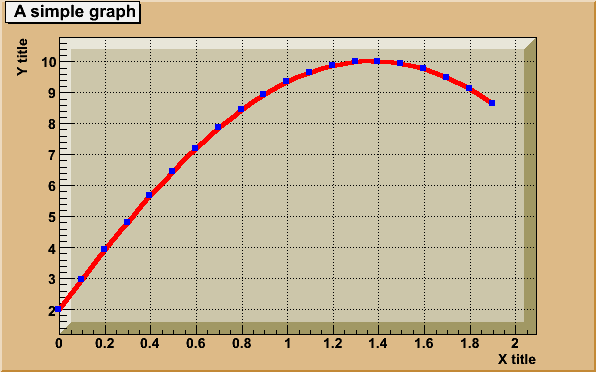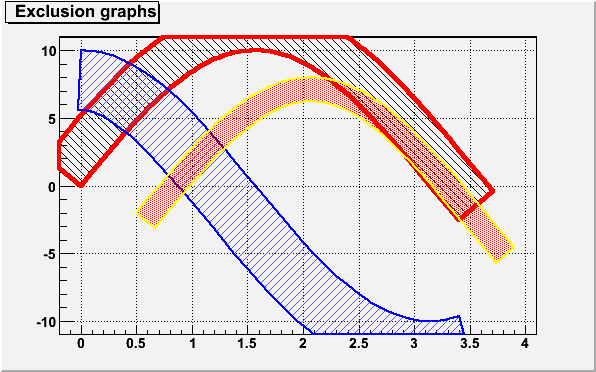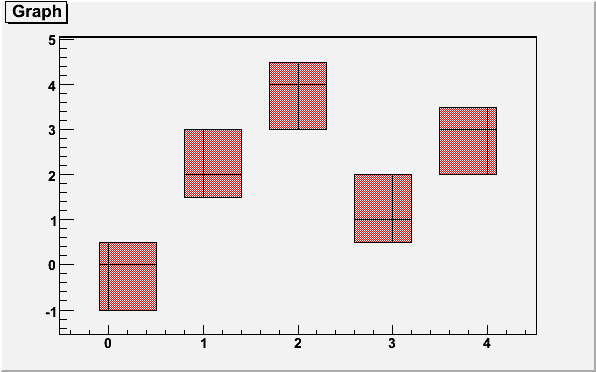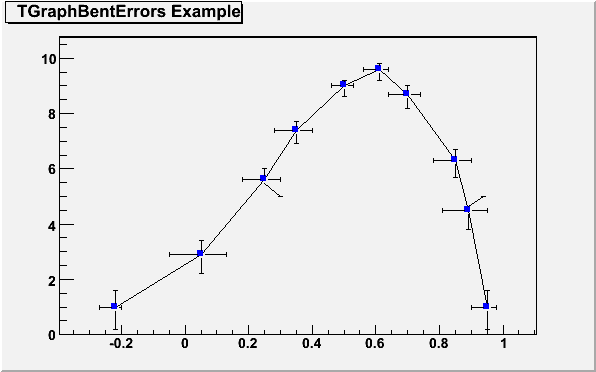class TGraphPainter: public TVirtualGraphPainter
The graph painter class
TGraph options

{
TCanvas *c1 = new TCanvas("c1","c1",200,10,600,400);
c1->SetFillColor(42);
c1->SetGrid();
const Int_t n = 20;
Double_t x[n], y[n];
for (Int_t i=0;i<n;i++) {
x[i] = i*0.1;
y[i] = 10*sin(x[i]+0.2);
}
gr = new TGraph(n,x,y);
gr->SetLineColor(2);
gr->SetLineWidth(4);
gr->SetMarkerColor(4);
gr->SetMarkerStyle(21);
gr->SetTitle("A simple graph");
gr->GetXaxis()->SetTitle("X title");
gr->GetYaxis()->SetTitle("Y title");
gr->Draw("ACP");
// TCanvas::Update() draws the frame, after which one can change it
c1->Update();
c1->GetFrame()->SetFillColor(21);
c1->GetFrame()->SetBorderSize(12);
c1->Modified();
return c1;
}Exclusion graphs
When a graph is painted with the option "C" or "L" it is possible to draw a filled area on one side of the line. This is useful to show exclusion zones. This drawing mode is activated when the absolute value of the graph line width (set thanks to SetLineWidth) is greater than 99. In that case the line width number is interpreted as 100*ff+ll = ffll . The two digits number "ll" represent the normal line width whereas "ff" is the filled area width. The sign of "ffll" allows to flip the filled area from one side of the line to the other. The current fill area attributes are used to draw the hatched zone.
TCanvas *exclusiongraph() { // Draw three graphs with an exclusion zone. //Author: Olivier Couet TCanvas *c1 = new TCanvas("c1","Exclusion graphs examples",200,10,600,400); c1->SetGrid(); TMultiGraph *mg = new TMultiGraph(); mg->SetTitle("Exclusion graphs"); const Int_t n = 35; Double_t x1[n], x2[n], x3[n], y1[n], y2[n], y3[n]; for (Int_t i=0;i<n;i++) { x1[i] = i*0.1; x2[i] = x1[i]; x3[i] = x1[i]+.5; y1[i] = 10*sin(x1[i]); y2[i] = 10*cos(x1[i]); y3[i] = 10*sin(x1[i])-2; } TGraph *gr1 = new TGraph(n,x1,y1); gr1->SetLineColor(2); gr1->SetLineWidth(1504); gr1->SetFillStyle(3005); TGraph *gr2 = new TGraph(n,x2,y2); gr2->SetLineColor(4); gr2->SetLineWidth(-2002); gr2->SetFillStyle(3004); gr2->SetFillColor(9); TGraph *gr3 = new TGraph(n,x3,y3); gr3->SetLineColor(5); gr3->SetLineWidth(-802); gr3->SetFillStyle(3002); gr3->SetFillColor(2); mg->Add(gr1); mg->Add(gr2); mg->Add(gr3); mg->Draw("AC"); return c1; }
TGraphErrors options
TGraphAsymmErrors options

{
TCanvas *c2 = new TCanvas("c2","c2",200,10,600,400);
double ax[] = {0, 1, 2, 3, 4};
double ay[] = {0, 2, 4, 1, 3};
double aexl[] = {0.1, 0.2, 0.3, 0.4, 0.5};
double aexh[] = {0.5, 0.4, 0.3, 0.2, 0.1};
double aeyl[] = {1, 0.5, 1, 0.5, 1};
double aeyh[] = {0.5, 1, 0.5, 1, 0.5};
TGraphAsymmErrors* gae = new TGraphAsymmErrors(5, ax, ay, aexl, aexh, aeyl, aeyh);
gae->SetFillColor(2);
gae->SetFillStyle(3001);
gae->Draw("a2");
gae->Draw("p");
return c2;
}TGraphBentErrors options

{
TCanvas *c3 = new TCanvas("c3","c3",200,10,600,400);
const Int_t n = 10;
Double_t x[n] = {-0.22, 0.05, 0.25, 0.35, 0.5, 0.61,0.7,0.85,0.89,0.95};
Double_t y[n] = {1,2.9,5.6,7.4,9,9.6,8.7,6.3,4.5,1};
Double_t exl[n] = {.05,.1,.07,.07,.04,.05,.06,.07,.08,.05};
Double_t eyl[n] = {.8,.7,.6,.5,.4,.4,.5,.6,.7,.8};
Double_t exh[n] = {.02,.08,.05,.05,.03,.03,.04,.05,.06,.03};
Double_t eyh[n] = {.6,.5,.4,.3,.2,.2,.3,.4,.5,.6};
Double_t exld[n] = {.0,.0,.0,.0,.0,.0,.0,.0,.0,.0};
Double_t eyld[n] = {.0,.0,.05,.0,.0,.0,.0,.0,.0,.0};
Double_t exhd[n] = {.0,.0,.0,.0,.0,.0,.0,.0,.0,.0};
Double_t eyhd[n] = {.0,.0,.0,.0,.0,.0,.0,.0,.05,.0};
TGraphBentErrors *gr = new TGraphBentErrors(n,x,y,exl,exh,eyl,eyh,exld,exhd,eyld,eyhd);
gr->SetTitle("TGraphBentErrors Example");
gr->SetMarkerColor(4);
gr->SetMarkerStyle(21);
gr->Draw("ALP");
return c3;
}TGraphPolar options
The drawing options for the polar graphs are the following values:| "O" | Polar labels are paint orthogonally to the polargram radius. |
|---|---|
| "P" | Polymarker are paint at each point position. |
| "E" | Paint error bars. |
| "F" | Paint fill area (closed polygon). |
| "A" | Force axis redrawing even if a polargram already exists. |
| "N" | Disable the display of the polar labels. |

{
TCanvas *c1 = new TCanvas("c1","c1",500,500);
TGraphPolar * grP1 = new TGraphPolar();
grP1->SetTitle("TGraphPolar example");
grP1->SetPoint(0, (1*TMath::Pi())/4., 0.05);
grP1->SetPoint(1, (2*TMath::Pi())/4., 0.10);
grP1->SetPoint(2, (3*TMath::Pi())/4., 0.15);
grP1->SetPoint(3, (4*TMath::Pi())/4., 0.20);
grP1->SetPoint(4, (5*TMath::Pi())/4., 0.25);
grP1->SetPoint(5, (6*TMath::Pi())/4., 0.30);
grP1->SetPoint(6, (7*TMath::Pi())/4., 0.35);
grP1->SetPoint(7, (8*TMath::Pi())/4., 0.40);
grP1->SetMarkerStyle(20);
grP1->SetMarkerSize(1.);
grP1->SetMarkerColor(4);
grP1->SetLineColor(4);
grP1->Draw("ALP");
// Update, otherwise GetPolargram returns 0
c1->Update();
grP1->GetPolargram()->SetToRadian();
return c1;
} 